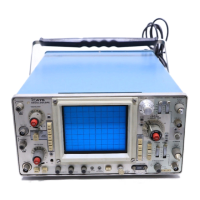TM 11-6625-2735-14-1
Trigger Source
Trigger SOURCE switch S505 selects the source of the
trigger signal. The sources available to the A Trigger
Generator circuit are the signal being displayed (NORM),
Channel 1 (CH 1), Channel 2 (CH 2), the instrument line
voltage (LINE), and external signals (EXT and EXT 10).
Emitter followers Q502, Q504, and Q506 provide isolation
between the input to the A Trigger Circuit and the output
of the Vertical Channel Switching Circuit.
In the LINE mode of triggering, a sample of the power
line frequency is obtained from the secondary of the
power transformer T1400 in the Low Voltage Power
Supply circuit. The Trigger COUPLING switches should
not be in the LF REJ mode when using the instrument line
voltage as a trigger signal source.
Trigger Coupling
The Trigger COUPLING switches offer a means of
accepting or rejecting certain components of the trigger
signal. In the AC, LF REJ, and HF REJ mode of trigger
coupling, the DC component of the trigger signal is
blocked by coupling capacitors C515 or C516. Frequency
components below about 60 Hz are attenuated when
using AC or HF REJ coupling and below about 50 kHz
when using LF REJ coupling. The higher frequency
components of the trigger signal are passed without
attenuation. In the HF REJ mode of trigger coupling, the
high frequency components of the trigger signal (above
about 50 kHz) are attenuated, while the lower frequency
components (between about 60 Hz and 50 kHz) are passed
without attenuation. The DC mode of trigger coupling
passes unattenuated all signals from DC to 200 MHz and
above.
Input Source Follower
Transistor Q522 is a FET (field-effect transistor) con-
nected as a source follower. It provides a high input
impedance (set primarily by R517) for the trigger signal; it
also provides isolation between the Trigger Generator
circuit and the trigger signal sources. CR519 provides
input protection for Q522 if excessively high amplitude
negative-going input signals are present. Q524 is a high-
impedance, relatively constant current source for Q522
and provides a measure of temperature compensation for
Q522. The output signal from the Source Follower is taken
from Emitter Follower Q526.
Paraphase Amplifier
U520 is a paraphase amplifier stage that converts the
single-ended input from Emitter Follower Q526 into a
dual-ended push-pull output, which is applied to one of
the Tunnel Diode Driver stages. Trigger Centering adjust-
ment R534 sets the level at pin 14 of U520 (through emitter
follower Q532) so that the display is correctly triggered
when the LEVEL control is centered. The LEVEL control
varies the level at pin 14 of U520 to select the point on a
trigger signal where triggering occurs.
The slope of the input signal that triggers the Sweep
Generator circuit is determined by the setting of the
SLOPE switch S530. When the SLOPE switch is set to the
+ position, the output signal at pin 8 of U520 is inverted
with respect to the input signal, and the output signal at.
pin 9 is in phase with respect to the input signal. When the
SLOPE switch is set to the – position, the output signal at
pin 8 is in phase with respect to the input signal, and the
output signal at pin 9 is inverted with respect to the input
signal.
Tunnel Diode Driver
Q552, Q556, Q562 and Q566 are common-emitter
amplifier stages that provide the signal currents necessary
to switch the triggering tunnel diodes. CR556 and CR566
are ten-milliampere tunnel diodes. Quiescently, CR556
and CR566 are biased into their low voltage states and
Q566 cannot provide sufficient current to switch CR566 to
its high voltage state. When the input signal increases the
current in Q556 slightly above its quiescent state, this
current and the current through R555 is sufficient to bias
CR556 into its high voltage state. The anode of CR556
steps positive to an approximately +0.5 volt level. Since
less current is required to maintain a tunnel diode in its
high voltage state than is required to switch it to its high
voltage state, approximately 6 mA of current is additional-
Iy available to switch CR566 to its high voltage state. Thus,
the next time Q566 conducts signal current, CR566 steps
to its high voltage state sending a positive pulse to the
logic circuit to initiate sweep action. The A Trig Sensitivity
adjustment, R565, adjusts the tunnel diode bias to the
proper level that will not allow CR566 to be switched to his
high voltage state until CR556 has been switched to its
high voltage state. At the end of the sweep time and during
holdoff, a negative level is applied to the junction of R558
and R566, thereby resetting both CR556 and CR566 to
their low voltage states. The reset level remains during
holdoff time to ensure that a sweep gating signal is not
generated until the sweep circuit has returned to its
quiescent state.
Trigger View Amplifier
The Trigger View Amplifier circuit amplifies a sample of
the signal present in the A Trigger Generator circuit and
passes it on to the Vertical Output Amplifier for display on
the CRT when the TRIG VIEW pushbutton impressed. This
provides a method of making a quick and convenient
check of the signal being used to trigger the oscilloscope
and is intended primarily to be used to check the timing
difference between the trigger signal and the vertical
deflection signal.
3-11

